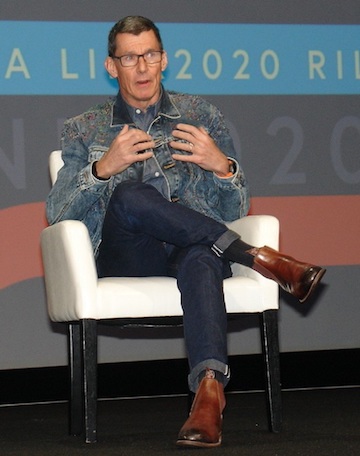Innovation is critical to the success of retailers at a time when consumers may well be buying less, according to the top executive of Levi Strauss & Co., addressing the Retail Industry Leaders Association’s supply chain forum Tuesday [Feb. 25] in Grapevine, Texas.

says retailers must develop innovative strategies. (Photo by Paul Scott Abbott, AJOT)
“If you don’t innovate, you die,” Chip Bergh, president and chief executive officer of the iconic San Francisco-based jeanswear leader, told attendees of LINK2020: The Retail Supply Chain Conference. “Innovation is our lifeblood.”
Bergh said he believes consumers will make fewer purchases as they participate more in the circular economy, including buying used clothing at thrift stores, wearing items a couple of weeks and then reselling them on websites such as thredUP.com.
“People aren’t going to need big closets in the future,” said Bergh, who worked 28 years for Procter & Gamble, last as group president for global male grooming, before assuming the top post at Levi Strauss in 2011. “You’ve got to figure out new revenue models because you might be selling less in the future.”
Bergh said innovation at Levi’s includes actions centering around social responsibility and sustainability, such as using lasers as opposed to water in the finishing process for jeans.
Levi’s has dramatically advanced its approach to e-commerce since Bergh joined the company nearly a decade ago, he said, noting that the jeanswear firm has increased its worldwide e-commerce workforce from three to more than 100.
Nonetheless, he said, “Our e-commerce business still loses money on a global basis. We should break even [on e-commerce] this year as the business continues to scale.”
Levi’s makes a greater profit when an item is sold via Amazon or Macy’s websites than on its own site, Bergh said.
Regarding the coronavirus outbreak, Bergh said Levi’s has hedged its sourcing by producing its goods in more than 20 countries throughout the world, with no more than 20 percent of total product coming from any one nation. He said China is at “the upper end” of such percentages but added that China already is back up to between 70 percent and 75 percent of pre-virus production level for Levi’s.
“It [the coronavirus] is going to have a short-term impact from a supply chain standpoint,” Bergh said. “Nobody really knows where this is going to wind up.”
In March 2019, Levi Strauss successfully debuted on the New York Stock Exchange under the ticker symbol LEVI. The company reported net revenue of nearly $5.8 billion for its latest fiscal year, ended Nov. 24, 2019.
Comprehensive coverage of the RILA conference, including reception photos, is scheduled to appear in print in the March 9 edition of AJOT.

